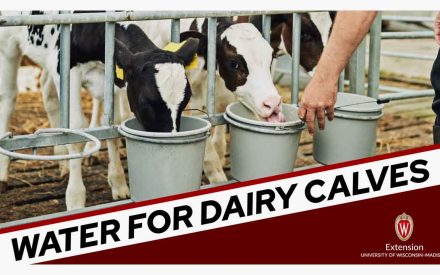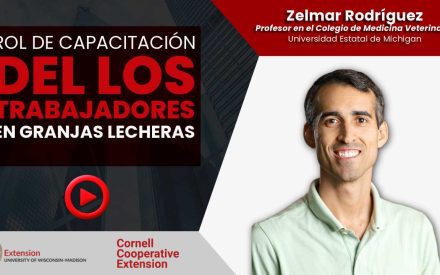When we talk about thermal stress in pre-weaned calves, often we discuss cold stress. However, calves can become environmentally stressed when temperatures are too cold or too hot. During extreme cold or hot temperatures, calves utilize extra energy to maintain their core body temperature. The temperature range at which a calf uses no additional energy to maintain its core body temperature is called the thermoneutral zone. A newborn calf maintains its core body temperature with no additional energy from 500 F to 770 F, while a one-month-old calf’s thermoneutral zone is 320 F to 730 F. At any temperature below or above the thermoneutral zone, a calf will begin to utilize the energy consumed through nutrients for core body temperature maintenance. This means fewer calories are used for growth and immune function.
The impact of heat stress in pre-weaned calves is generally overlooked, with focus on the milking herd. Calves are much smaller animals than their adult counterparts, producing less body heat from rumination and having a greater relative surface area for heat loss. Even within the thermoneutral zone, however, calves can begin to experience discomfort and use their natural thermoregulatory mechanisms, described below, to keep cool.
Signs of heat-stressed calves
- Reduce movement
- Decrease feed intake
- Increase water consumption
- Increase respiration rate
- Open-mouth breathe
- Increase standing time, lying less
It is beneficial to observe these signs and intervene with heat abatement strategies before the negative impacts of heat stress impact health, growth, and animal well-being.
Strategies to beat the negative impacts of heat

When caring for calves, we can use our internal temperature indicator as a reminder we may need to adjust best management practices to help calves combat heat stress. When we take off our jackets in the spring and wear short sleeves, it is time to plan and prepare for summer’s calf heat abatement program. As temperatures increase, we need to adjust calf care accordingly by providing additional nutrients, water, shade, ventilation, and fly control to minimize the negative impacts of heat stress. There are many low-cost options and best management practices that can be adopted to minimize the impact of heat stress on pre-weaned calves.
- Provide shade over hutches with trees or other natural shade to reduce radiant heat, or a temporary shade high enough as not to impede air flow. If using shade cloth, select material rated to block at least 80 percent of UV light to reduce the temperature inside a calf hutch.
- Reduce stocking density in group housing systems. Place calf hutches four feet apart with 10 feet between rows to allow air to circulate around hutches.
- Orient new calf barns east to west. Orienting new facilities east to west to avoid extreme afternoon sun exposure in the pen.
- Improve air flow and movement to reduce illness and the need for calves to expend extra energy to maintain core body temperature. For hutches, open all vents and doors, as well as prop the backside of the hutch 4 to 6 inches to promote air flow. Based on preliminary UW-Madison research, respiratory rates of calves in a ventilated hutch were observed to decline by 10 to 20 breaths per minute over an hour time frame as compared to those calves housed in non-ventilated hutches. For indoor calf pens, open all sidewalls to maximize natural ventilation. Calf pen design should have solid panels between each calf for biosecurity purposes, and open front and back sides to provide greater opportunity for breezes to move through the pens in warm weather when the curtain side walls are open. Consider installing fans, which have been shown to improve starter intakes and weight gains in summer.
- Access to ample, fresh, cool water. Calves can double the amount of water they consume during heat stress to replenish body fluids they have lost through sweating and panting.
- Maintain clean, dry bedding. Avoid the use of straw in summer, as it can insulate the calf when lying down, and utilize sand bedding to help dissipate body heat. Sand also can help control flies that may spread disease.
- Increase the plane of nutrition to meet caloric needs for both growth and maintaining body temperature. Calf energy requirements can increase 20 to 30 percent during times of heat stress. As with cold stressed calves, increase milk volume or milk solids to increase nutrients, or feed an additional feeding to increase levels. Research suggests calves fed three times a day will have optimal growth, better feed efficiency, and consume more starter.
- Offer fresh feed at each feeding to promote consumption.
- Feed calves before and after peak heat and humidity. Schedule feeding so calves can digest feed (typically four hours after consumption) during the non-peak temperature part of the day.
- Minimize mold, algae, and bacteria growth in buckets and waterers by cleaning them daily. Keeping equipment clean will minimize the growth of bacteria and disease-causing organisms, as well as controlling fly populations.
- Perform stressful activities such as moving, grouping, handling, disbudding, or vaccination during cooler, early morning hours. Even if evening temperatures are cooler, it takes a calf’s body four to six hours to reach normal body temperature after a hot day.
You can help calves beat the heat by closely monitoring calf behavior and making a few easy, detailed changes to the normal routine can make a huge impact on the calf’s well-being and long-term performance.
Download Article

 The importance of water for dairy calves
The importance of water for dairy calves ▶️ Watch: Entendiendo el ciclo estral bovino para mejorar la detección de calores
▶️ Watch: Entendiendo el ciclo estral bovino para mejorar la detección de calores ▶️ Watch: Hay There! Let’s Talk Feed Centers and Inventory
▶️ Watch: Hay There! Let’s Talk Feed Centers and Inventory ▶️ Watch: Prácticas de manejo para mejorar la calidad del forraje
▶️ Watch: Prácticas de manejo para mejorar la calidad del forraje


